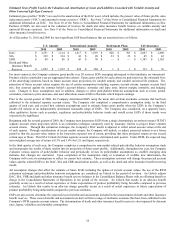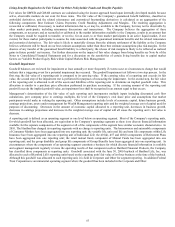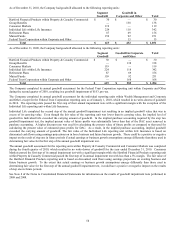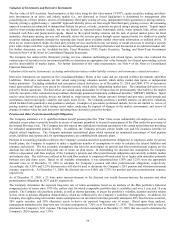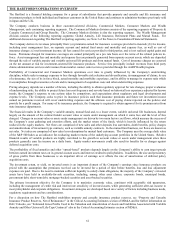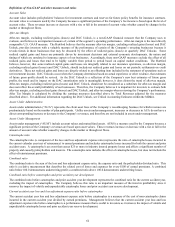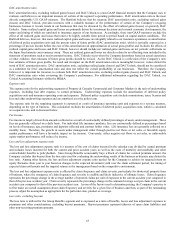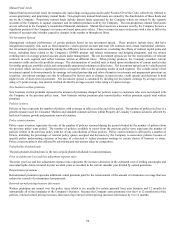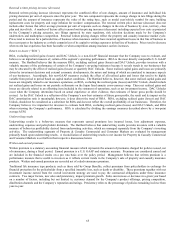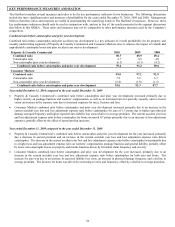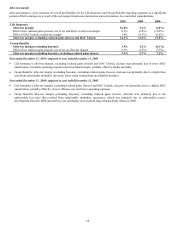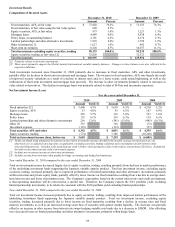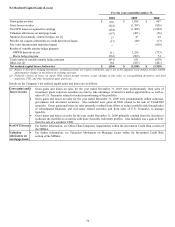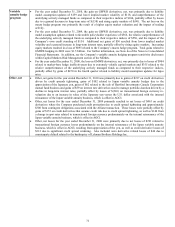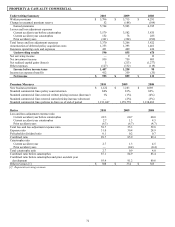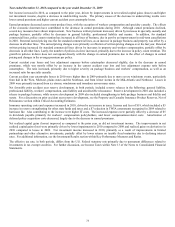The Hartford 2010 Annual Report Download - page 63
Download and view the complete annual report
Please find page 63 of the 2010 The Hartford annual report below. You can navigate through the pages in the report by either clicking on the pages listed below, or by using the keyword search tool below to find specific information within the annual report. 63
DAC amortization ratio
DAC amortization ratio, excluding realized gains (losses) and DAC Unlock, is a non-GAAP financial measure that the Company uses to
evaluate, and believes is an important measure of, certain of the segment’ s operating performance. DAC amortization ratio is the most
directly comparable U.S. GAAP measure. The Hartford believes that the measure DAC amortization ratio, excluding realized gains
(losses) and DAC Unlock, provides investors with a valuable measure of the performance of certain of the Company’ s on-going
businesses because it reveals trends in our businesses that may be obscured by the effect of realized gains (losses) or quarterly DAC
Unlocks. Some realized capital gains and losses are primarily driven by investment decisions and external economic developments, the
nature and timing of which are unrelated to insurance aspects of our businesses. Accordingly, these non-GAAP measures exclude the
effect of all realized gains and losses that tend to be highly variable from period to period based on capital market conditions. The
Hartford believes, however, that some realized capital gains and losses are integrally related to our insurance operations, so amortization
of deferred policy acquisition costs and the present value of future profits (DAC amortization ratio), which is typically expressed as a
percentage of pre-tax income before the cost of this amortization (an approximation of actual gross profits) and excludes the effects of
realized capital gains and losses and DAC Unlock, however should include net realized gains and losses on net periodic settlements on
the Japan fixed annuity cross-currency swap. These net realized gains and losses are directly related to an offsetting item included in the
statement of operations such as net investment income. DAC Unlocks occur when the Company determines based on actual experience
or other evidence, that estimates of future gross profits should be revised. As the DAC Unlock is a reflection of the Company’ s new
best estimates of future gross profits, the result and its impact on the DAC amortization ratio is meaningful; however, it does distort the
trend of DAC amortization ratio. DAC amortization ratio, excluding realized gains (losses) and DAC Unlock, should not be considered
as a substitute for DAC amortization ratio and does not reflect the overall profitability of our businesses. Therefore, the Company
believes it is important for investors to evaluate both DAC amortization ratio, excluding realized gains (losses) and DAC Unlock, and
DAC amortization ratio when reviewing the Company’ s performance. For additional information regarding the DAC Unlock, see
Critical Accounting Estimates within the MD&A.
Expense ratio
The expense ratio for the underwriting segments of Property & Casualty Commercial and Consumer Markets is the ratio of underwriting
expenses, excluding bad debt expense, to earned premiums. Underwriting expenses include the amortization of deferred policy
acquisition costs and insurance operating costs and expenses. Deferred policy acquisition costs include commissions, taxes, licenses and
fees and other underwriting expenses and are amortized over the policy term.
The expense ratio for the remaining segments is expressed as a ratio of insurance operating costs and expenses to a revenue measure,
depending on the type of business. This calculation excludes the amortization of deferred policy acquisition costs, which is calculated
as a separate ratio, and is discussed below.
Fee Income
Fee income is largely driven from amounts collected as a result of contractually defined percentages of assets under management. These
fees are generally collected on a daily basis. For individual life insurance products, fees are contractually defined as percentages based
on levels of insurance, age, premiums and deposits collected and contract holder value. Life insurance fees are generally collected on a
monthly basis. Therefore, the growth in assets under management either through positive net flows or net sales, or favorable equity
market performance will have a favorable impact on fee income. Conversely, either negative net flows or net sales, or unfavorable
equity market performance will reduce fee income.
Loss and loss adjustment expense ratio
The loss and loss adjustment expense ratio is a measure of the cost of claims incurred in the calendar year divided by earned premium
and includes losses incurred for both the current and prior accident years, as well as the costs of mortality and morbidity and other
contractholder benefits to policyholders. Since Group Benefits occasionally buys a block of claims for a stated premium amount, the
Company excludes this buyout from the loss ratio used for evaluating the underwriting results of the business as buyouts may distort the
loss ratio. Among other factors, the loss and loss adjustment expense ratio needed for the Company to achieve its targeted return on
equity fluctuates from year to year based on changes in the expected investment yield over the claim settlement period, the timing of
expected claim settlements and the targeted returns set by management based on the competitive environment.
The loss and loss adjustment expense ratio is affected by claim frequency and claim severity, particularly for shorter-tail property lines
of business, where the emergence of claim frequency and severity is credible and likely indicative of ultimate losses. Claim frequency
represents the percentage change in the average number of reported claims per unit of exposure in the current accident year compared to
that of the previous accident year. Claim severity represents the percentage change in the estimated average cost per claim in the current
accident year compared to that of the previous accident year. As one of the factors used to determine pricing, the Company’ s practice is
to first make an overall assumption about claim frequency and severity for a given line of business and then, as part of the ratemaking
process, adjust the assumption as appropriate for the particular state, product or coverage.
Loss ratio, excluding buyouts
The loss ratio is utilized for the Group Benefits segment and is expressed as a ratio of benefits, losses and loss adjustment expenses to
premiums and other considerations, excluding buyout premiums. Buyout premiums represent takeover of open claim liabilities and
other non-recurring premium amounts.




